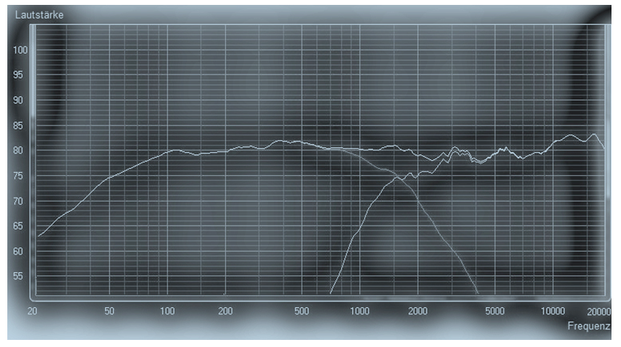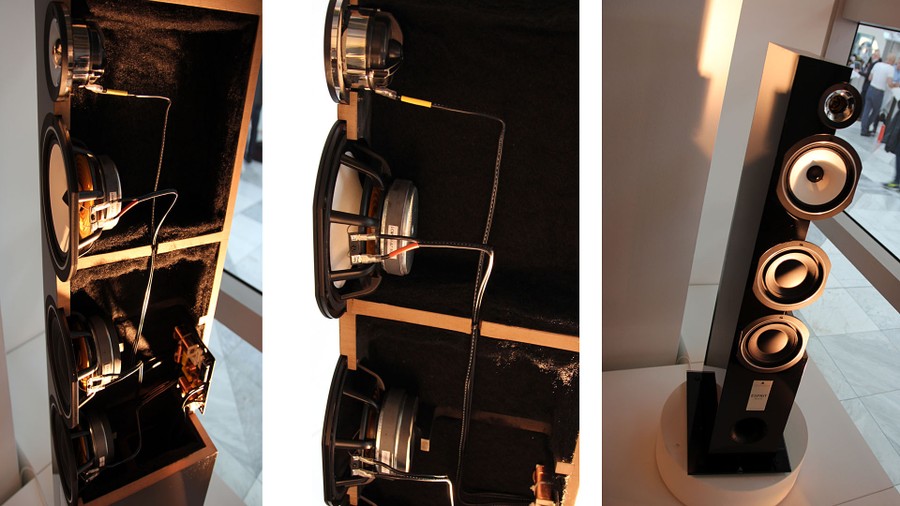6. Excursus: speaker construction - www.hifilounge.eu
Main menu:
- Home
- General
-
Speakers
- Basics
- Speakers
- Headphones
- Subwoofer
- Elektronics
- Surround
- Photography
- Infos
6. Excursus: speaker construction
Speakers > Speakers
This page is not primarily aimed at handicraf hobbyists - even if it would be nice if some readers discovered a new hobby in this area for themselves. For a practical understanding of the effects of crossovers, an excursus on the construction of a simple loudspeaker concept seems to make sense at this point. The goal is a small two-way loudspeaker for stereo applications or for a home cinema. Figure 1 shows examples of such loudspeakers.

Figure 1: Two-way stereo speaker
The tweeter is a standard 25mm diameter dome tweeter. The amplitude frequency response is known from the data sheet of the tweeter. This indicates how loud the loudspeaker is at which frequency.

Figure 2: Frequency response of the tweeter
It is not surprising that the tweeter performes very poor at lower frequencies (below 1000Hz). It is simply not designed for those frequencies.
The solution: At lower frequencies the tweeter is supported by a bass-midrange driver with a diameter of 5 inches - that's about 13cm. We will build the woofer with the tweeter in a wooden cabinet.
Some manufacturers specify the required cabinet volume on the data sheet, but it can also be easily calculated with (often free) software. A short internet search makes a crossover frequency for the crossover at 2000Hz seems reasonable. Elsewhere on this website you will find a more detailed explanation of the effect of the crossover frequency.

Figure 3: Tweeter and bass-midrange driver with crossover
The following is noticeable when looking at the frequency response:
- The crossover intervenes at 2000Hz. The tweeter becomes quieter below the crossover frequency as desired and the mid-bass driver is throttled more and more at higher frequencies. But the effect is noticeable through a wider frequency response, in this range both drivers work in parallel - leading to interference between the drivers.
- The frequency response has a distinct gradient: The loudspeaker becomes louder at higher tones. The loudspeaker would sound shrill in this way. Speakers concentrate the sound more and more at higher frequencies, in the preferred dispersion direction of the loudspeaker the tweeter of the loudspeaker becomes louder as a result. Further to the side of the main direction, the tweeter becomes quieter.
- For a harmonious sound the tweeter has to be slowed down a bit. For this purpose, resistors are connected in front of the tweeter - the electrical engineer knows the wiring as a "voltage-divider". Now the tweeter is partly converted into heat in the resistors. The sound impression loses its shrillness and becomes much more homogeneous.
A specifically connected capacitor in the crossover also attenuates the low-midrange driver a little at higher frequencies. After a little experimentation, the frequency response looks much more even.

Figure 4: Attenuation of the tweeter by attenuators
The resulting loudspeaker could be improved in several places. Other drivers could be used, the choice of crossover frequencies was somewhat arbitrary. And not a word was said about the dispersion behaviour, the harmonic values, maximal level...
Nevertheless, the speaker would already be fully functional and would even sound nice.
A commercially successful loudspeaker would of course be a few steps away. This of course includes, for example, an additional bass loudspeaker chassis, a clean cable routing in the loudspeaker and a professional painting of the cabinet. Below you can see how the end result can look with a professional approach.

Figure 5: Triangle Esprit as Showcase Speaker
Properly manufactured crossover, cabling, chassis - that's what a finished commercial loudspeaker looks like! The generous use of damping material and a good paint finish is almost a matter of course.